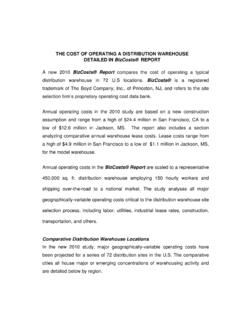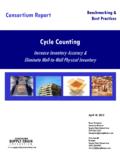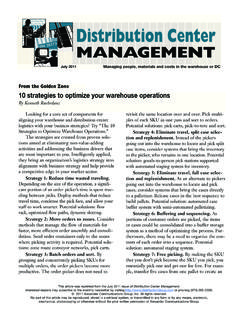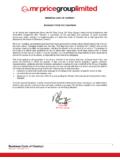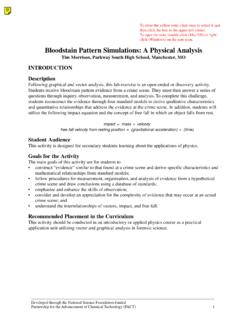Transcription of Seven Wastes of Logistics-Whitepaper0807 - Distribution …
1 Lehigh University Center for Value Chain Research ~inchain 1 August, 2007 The Seven Deadly Wastes of logistics : Applying Toyota Production System Principles to Create logistics Value Joel Sutherland Managing Director Center for Value Chain Research Lehigh University, 621 Taylor Street, Bethlehem, PA 18015 E-mail: Bob Bennett President Lean Consulting Associates, LLC, and Group Vice President (retired) Toyota Motor Sales USA, Inc. 16 Deerhill Drive Rolling Hills Estates, CA 90274 E-mail: CVCR White Paper #0701 Abstract A business value chain is an end-to-end set of activities that can be applied to a product or service making it ready for the next activity. Most resources used in an activity add value some do not.
2 The resources consumed (such as people, time or equipment) that do not add value add cost and should be eliminated. This is the essence of the Toyota Production System, or Lean (the term used in the for what was originally known as the "Toyota Production System"). This article reviews the evolution of Lean principles from the beginning of Henry Ford s revolutionary assembly line process for his Model T automobile in the early 1900 s, through Taiichi Ohno s creation of the famous Toyota Production System in the mid-20th century, to adoption of these principles in addressing today s logistics and transportation challenges. This paper presents real examples from executives who worked within the Toyota Production System and were effective in expanding these principles beyond the traditional manufacturing/ assembly environment.
3 Lehigh University Center for Value Chain Research ~inchain 2 Introduction Henry Ford said that Quality means doing it right when no one is looking. If Henry Ford knew the value of doing it right the first time, then why does this basic practice seem to be missing from so many companies today? The answer it s hard. It requires a rigorous approach to problem solving, a relentless effort to identify and eliminate all forms of inefficiency, and a commitment to change the corporate culture that few firms are willing to embrace. In fact, a recent study by the management consulting firm Bain & Company found that only 19% of companies that have attempted to implement lean are happy with the results. Early in the twentieth century, Henry Ford took all the elements of a manufacturing system and arranged them in a continuous system for manufacturing the Model T automobile.
4 After World War II, Taiichi Ohno at Toyota Motor Company recognized the benefits of this system and began to incorporate the Ford production system into an approach called the Toyota Production System (TPS), a system even better than Ford s at doing it right the first time by applying continuous problem solving by every employee to make the system ever stronger. In the decades that have followed, Toyota has diligently applied these principles and, in the first quarter of 2007, passed General Motors to become the world s No. 1 auto seller ( ). Fundamentals of TPS: Muda, Process Focus, Genchi Genbutsu, Kaizen, Mutual respect While TPS has been discussed and written about for decades, a precise process has never been documented.
5 An effective manual or a how to book has never been created that provides a step-by-step approach for understanding and implementing TPS nor can such a complex process be adequately documented. Instead, newcomers to TPS are provided a daily lesson by Japanese mentors in the art of identifying and eliminating waste . Much like a child learns and forms habits from every action his or her parents take, newcomers to TPS learn from their Japanese parents . For example, within TPS there are many Toyota Way principles that need to be clearly understood and successfully applied before the benefits of TPS can be fully realized. But there are five in particular that are fundamental to TPS process. Once you grasp these you ll be able to take the first steps on your Lean journey.
6 TPS strives for total elimination of muda (anything that is wasteful and doesn t add value), through a process focus (where managers work cross-organizationally to develop and sustain robust business processes), using genchi genbutsu (collecting facts and data at the actual site of the work or problem), and kaizen (continuous and incremental process improvement), with a value of mutual respect (between management and employees and business partners). Muda adds unnecessary cost, quality problems, and lead-time to business processes. Process focus creates a capable and stable value stream. Applying genchi genbutsu provides the necessary understanding of how work is actually done so standardized processes can be developed, and lets us see problem causes for kaizen problem solving to eliminate muda.
7 This may be the most difficult principle for traditional companies and managers to embrace, since it requires an attention to detail that seems to fly in the face of making Wall Street quarterly numbers and speedy decision making. The purpose of kaizen is to involve every employee in the identification and elimination of all forms of muda, thereby creating value. This is commonly referred to as the kaizen process, which uses the scientific method of problem solving at the Lehigh University Center for Value Chain Research ~inchain 3 lowest possible level in the organization. Mutual respect between management and employees reflects a true respect and sense of responsibility from management. This mutual respect is exemplified by employee safety, lifelong learning, and nurturing and coaching of every employee to enable them to contribute their full human potential to improve their job and business processes for the betterment of the company.
8 This is core to the kaizen process. Anyone who has experienced TPS first-hand is well aware of how these five principles are applied and interconnected. It would be common, for example, to see an experienced Toyota veteran observing a production or Distribution operation and taking notes often for hours at a time. To the uninitiated observer, it would appear that little value was being created, when in fact the opposite is true. There is a well known story about one of the techniques used by Ohno when visiting a plant. It is said that Ohno would draw a circle the Ohno circle on the floor and order one member of his staff to stand within the circle, sometimes for the entire day. The objective was to closely observe the operation (genchi genbutsu, identify inefficiencies (muda), and record areas of opportunity.)
9 Next, a plan for process improvement would be developed and executed. This is what genchi genbutsu and kaizen are all about. When teaching American managers about problem solving for kaizen, a Japanese staff member would typically apply the Five Why s process (the practice of repeatedly asking why about the suspected cause at least five times to get to the root cause or causes of the problem). For example, after observing and identifying an opportunity for improvement, a Japanese staff member would discuss the opportunity with his American counterpart. Rather than identifying the actual improvement and dictating a solution, the Japanese staff member would ask a series of questions (the Five Why s) that would nudge the American to make a decision that he had already determined through analysis was appropriate.
10 This is the cultural educational process that all Americans (or non-Japanese) must go through to learn and ultimately master TPS. Here is an example of how the Five Why s might be applied: The Washington Monument was disintegrating Why? Use of harsh chemicals Why? To clean pigeon poop Why so many pigeons? They eat spiders and there are a lot of spiders at the monument Why so many spiders? They eat gnats and there are a lot of gnats at the monument Why are there so many gnats? They are attracted to the light at dusk Solution: Turn on the lights at a later time. The Seven Deadly Wastes of the Toyota Production System The relentless elimination of waste is as important today as it was when Taiichi Ohno identified the primary sources of waste , which he called The Seven Deadly Wastes .

